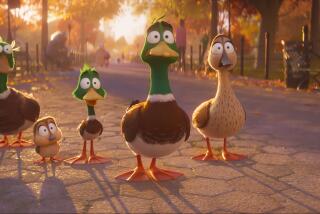In ‘Surf’s Up,’ penguins again are the go-to birds
- Share via
In the animated world, penguins are capable of just about anything.
In the Oscar-winning short “The Wrong Trousers,” one of the little birds was a wily, silent thief. In “Madagascar,” penguins were wisenheimers that managed to skipper a boat. In the Oscar-winning feature “Happy Feet,” they could sing like -- well, birds -- and dance like Savion Glover.
And in the new computer-animated family film “Surf’s Up,” which opens Friday, penguins are groovy surfers.
Lauren DuBois, assistant curator of birds at SeaWorld San Diego’s Penguin Encounter, believes the animals are popular because “they are not like what you would expect a bird to look like. And they do have these personalities. I think that is what draws people in.”
Their colors help too. “I think there is also something about black-and-white animals,” she says. “We have seen that in the park with our killer whales ... and penguins.”
DuBois says the Oscar-winning documentary “The March of the Penguins” captured how penguins live. “When you get a chance to look at the animals, you realize how incredible these little birds are.”
Whereas the penguins in “Happy Feet” were emperor penguins, the tallest and heaviest of the species, the key characters in “Surf’s Up” -- Cody Maverick, the up-and-coming teenage surfer, and the Big Z, the washed-up surfer dude he idolizes -- are rockhoppers, a smaller, aggressive crested species. So named because they jump from rock to rock, the breed used to be hunted for its oil. The birds are now protected.
Though Cody and his film flock hail from Antarctica, Dubois says such birds are actually found in islands off South America.
DuBois believes films like “Surf’s Up,” “Happy Feet” and “March of the Penguins” have helped immeasurably in educating audiences. “The more we learn, the more we can pass on to our children,” she says.
It works the other way too. “I find, actually, the kids who come to see these movies take that information and pass it on to their parents,” DuBois says. “And their parents become more aware of things that are going on in the environment.”
*
-- Susan King
More to Read
Sign up for The Wild
We’ll help you find the best places to hike, bike and run, as well as the perfect silent spots for meditation and yoga.
You may occasionally receive promotional content from the Los Angeles Times.







